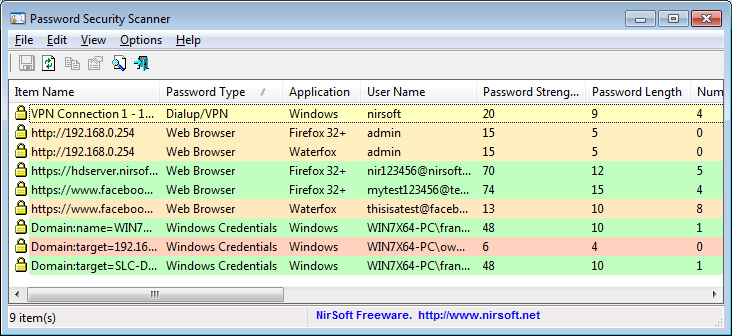This utility scans the passwords stored by popular Windows applications
(Microsoft Outlook, Internet Explorer, Mozilla Firefox, and more...)
and displays security information about all these passwords.
The security information of every stored password includes the total
number of characters,
number of numeric characters, number of lowercase/uppercase characters,
number of repeating characters,
and password strength.
You can use this tool to determine whether the passwords used by other
users are secured enough,
without watching the passwords themselves.

System Requirements
This utility works on any version of Windows, starting from Windows 2000 and up to Windows 7.Supported Applications
Currently, Password Security Scanner scans the passwords of the following applications:- Internet Explorer 4.0 - 6.0
- Internet Explorer 7.0 - 9.0
- Mozilla Firefox (All Versions)
- Dialup/VPN passwords of Windows
- MSN/Windows Messenger
- Microsoft Outlook
- Windows Live Mail
Support for more applications will be added in future versions.
Known Limitations
- Password Security Scanner cannot scan the passwords of Firefox if they are protected by a master password.
- The dialup passwords of Windows can only be detected if you run Password Security Scanner with administrator privileges.
Start Using Password Security Scanner
Password Security Scanner doesn't require any installation process or additional dll files. In order to start using it, simply run the executable file - PasswordScan.exeAfter you run PasswordScan.exe, Password Security Scanner scans the passwords stored on your system, and then displays the security information of all found passwords inside the main window.
You can also go to the 'Advanced Options' window (F9) and choose to displays only insecure passwords with low number of characters or with low password strength value.
Columns Description
- Item Name: The name of the item. For Web site passwords, the address of the Web site is displayed. For email passwords, the email address is displayed.
- Password Type: The type of the password: Web Browser, Messenger, Email, or Dialup/VPN.
- Application: The application that stores the specified password item: Microsoft Outlook, Firefox, Internet Explorer, and so on...
- User Name: The user name that is used with the specified password item.
- Password Length: The total number of characters in the password.
- Numeric: The total number of numeric characters (0 - 9) in the password.
- Lowercase: The total number of lowercase characters (a - z) in the password.
- Uppercase: The total number of uppercase characters (A - Z) in the password.
- Other Ascii: The total number of non-alphanumeric characters in the password.
- Non-English: The total number of non-English characters in the password.
- Repeating: The total number of repeating characters in the password. For example, if the password is abcdab, then the 'Repeating' value will be 2, because both a and b characters appears more than once.
- Password Strength:
The strength of the password, calculated according to number of parameters, including
the total number of characters, number of repeating characters, type of characters used in the passwords, and more...
The numeric value displayed in this column represents the strength of the password, according to the following list:- 1 - 7: Very Weak
- 8 - 14: Weak
- 15 - 25: Medium
- 26 - 45: Strong
- 46 and above: Very Strong
- Windows User: The Windows user that owns the password. For most passwords, this column will display the current logged-on user. However, for Dialup passwords of Windows, you might also see the passwords of other Windows users, and in those cases, this column will display the Windows users that created the dialup password.
Translating Password Security Scanner to other languages
In order to translate Password Security Scanner to other language, follow the instructions below:- Run Password Security Scanner with /savelangfile parameter:
PasswordScan.exe /savelangfile
A file named PasswordScan_lng.ini will be created in the folder of PasswordScan utility. - Open the created language file in Notepad or in any other text editor.
- Translate all string entries to the desired language. Optionally, you can also add your name and/or a link to your Web site. (TranslatorName and TranslatorURL values) If you add this information, it'll be used in the 'About' window.
- After you finish the translation, Run PasswordScan.exe, and all translated
strings will be loaded from the language file.
If you want to run PasswordScan without the translation, simply rename the language file, or move it to another folder.









 Friday, December 23, 2011
Friday, December 23, 2011
 Anu
Anu


 Posted in
Posted in





0 comments:
Post a Comment